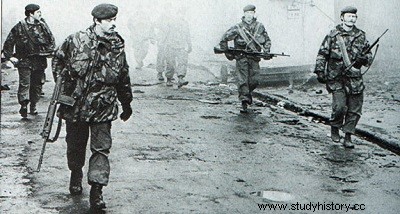
"Disembark where and when you want, but with the minimum of damage, material and above all human..." The instructions given by London to Admiral "Sandy" Woodward, supreme manager of the British expedition to the Falkland Islands (Malvinas) , were clear. But implementing them was not easy. For a month from mid-April to mid-May - aboard the British Task Force exposed to enemy air strikes, the strategists gathered around Woodward reviewed all possible options.
Establish a bridgehead? Yes but where ? The British knew the terrain. Shock troops had repeatedly carried out maneuvers in the Falkland Islands. But nothing should be left to chance. For weeks, while waiting to have all the forces mobilized, the on-board staff multiplied naval bombardments, reconnaissance air raids, raids carried out by teams of the famous S.A.S. (Special Air Service) and S.B.S. (Special Boat Section) in order to test the enemy's defense system and collate a mass of information essential to the success of a landing.
The choice of Admiral Woodward and his officers is finally focused on the bay of Port San Carlos. Located at the northwestern end of Soledad Island, at the entrance to Falkland Sound, the strait that separates the two main islands of the archipelago, this protected site offered them optimal guarantees for the success of the landing. . Very small Argentine military presence, starting point of two tracks leading to Port Stanley, the final objective, natural shelter to be used for unloading operations from transport ships, coastal topography with little ruggedness. The ideal place...
All that remained was to choose the “D” day. It was May 20.
Or more precisely the night of the 20th to the 21st. Less than 24 hours after receiving the green light from London, taking advantage of the darkness and the diversionary operations carried out by several units of the Royal Navy at various points in the archipelago, the first units of the British intervention force regained a foothold on the Falklands. Sent at nightfall through the strait by several ships accompanying the squadron, including the liner Canberra, the ferry Norland and the troop transport H.M.S. Fearless, immediately transferred to landing craft, the Royal Marines commandos landed without encountering any resistance. Offshore, several missile frigates and destroyers provided cover for the operation.
The Argentine observation posts placed on the heights overlooking the bay had noticed nothing. It was not until daybreak, Friday the 21st, that first by these lookouts, then by observation flights, the staff of the Argentinian General Menendez installed in Port Stanley learned what was happening in the other end of the island. Probably persuaded to find themselves faced with a new one-off harassment operation of the type successful a few days earlier by the British troops on Pebble Island, the Argentines immediately responded by calling on the bombardment squadrons based on the mainland. .
All day Friday, Argentine airmen and British gunners fought a merciless battle for control of the air while shuttles multiplied between the ships and the shore to land men and equipment. A fierce duel that the anti-aircraft batteries of the Royal Navy, handicapped by the virtual absence of air support, and by the reduced mobility of the ships in these shallow waters, led almost alone. In any case, until the first sections of Blowpipe and Rapier anti-aircraft missiles are put in battery on the ground.
This battle will be worth to the British navy the loss of its second large surface unit since the beginning of the conflict:the frigate H.M.S. Ardent, sent from the bottom by about fifteen enemy missiles. Competing in audacity, the pilots of the Skyhawks, Mirage IIIs and Argentinian Daggers also damaged several other ships, without however succeeding in beating the retreating British troops. On the contrary, by the evening of Friday the 21st, more than a thousand Royal Marines and paratroopers from the 2nd and 3rd Airborne Regiments held their positions firmly while with every passing hour reinforcements continued to arrive.
During the next six days, and despite the daily raids by the Argentine air force intercepted from time to time by the "jump-jet" Harriers of the British naval aviation, the landing forces, placed under the command of Brigadier -General Julian Thompson, consolidated and widened the bridgehead in order to transform it into a rear base before embarking on the conquest of the island.
On May 27, British troops ashore, whose numbers then reached nearly 5,000 men, began to move towards Port Stanley, 80 kilometers away, to the east. The assault forces divided into two groups attack the two routes leading to the capital of the Falklands. The 20th, 42nd and 45th Commandos of the Royal Marines head for their objective via the north track, a path made difficult to pass at the start of the austral winter by the constant rains.
By the south track , the 2nd and 3rd Parachute Regiments advanced under similar conditions towards the first sizable Argentine garrison, more than 1,500 men defending the small town of Port Darwin and the Goose Green airfield two kilometers away. penalty.
